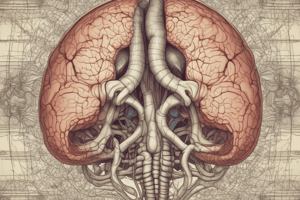Podcast
Questions and Answers
Which brain structure is primarily involved in coordinating movement and balance?
Which brain structure is primarily involved in coordinating movement and balance?
- Basal ganglia
- Brainstem
- Cortex
- Cerebellum (correct)
Which of the following is NOT a common motor disorder seen in clinics?
Which of the following is NOT a common motor disorder seen in clinics?
- Amyotrophic Lateral Sclerosis (ALS)
- Huntington's Disease
- Parkinson's Disease
- Tourette Syndrome (correct)
Which area of the brain is associated with voluntary movement and procedural learning?
Which area of the brain is associated with voluntary movement and procedural learning?
- Cerebellum
- Brainstem
- Cortex (correct)
- Thalamus
In Parkinson's Disease, there is a decrease in the neurotransmitter:
In Parkinson's Disease, there is a decrease in the neurotransmitter:
Damage to the basal ganglia can result in disturbances in:
Damage to the basal ganglia can result in disturbances in:
Which motor system structure is primarily responsible for fine-tuning and coordinating movement?
Which motor system structure is primarily responsible for fine-tuning and coordinating movement?
Which disorder is characterized by a progressive loss of dopaminergic neurons in the substantia nigra region of the brain?
Which disorder is characterized by a progressive loss of dopaminergic neurons in the substantia nigra region of the brain?
Which part of the brain plays a crucial role in procedural learning and skilled voluntary movements?
Which part of the brain plays a crucial role in procedural learning and skilled voluntary movements?
Which neurological disorder is linked to a deficiency of the neurotransmitter dopamine in the brain?
Which neurological disorder is linked to a deficiency of the neurotransmitter dopamine in the brain?
Damage to which brain structure can lead to abnormalities in initiating voluntary movements and coordinating motor functions?
Damage to which brain structure can lead to abnormalities in initiating voluntary movements and coordinating motor functions?



